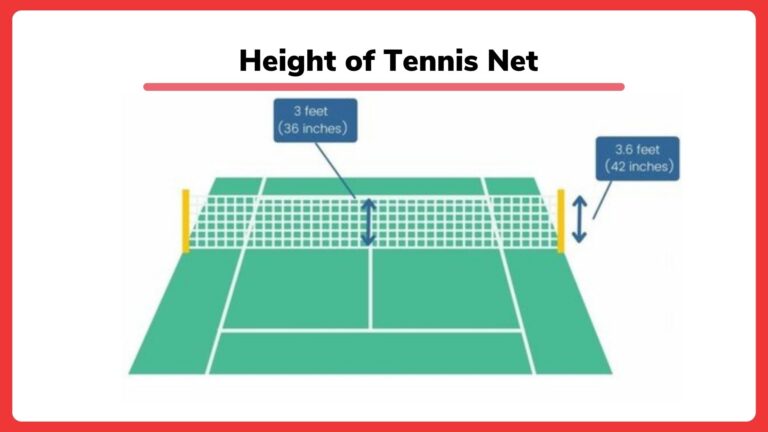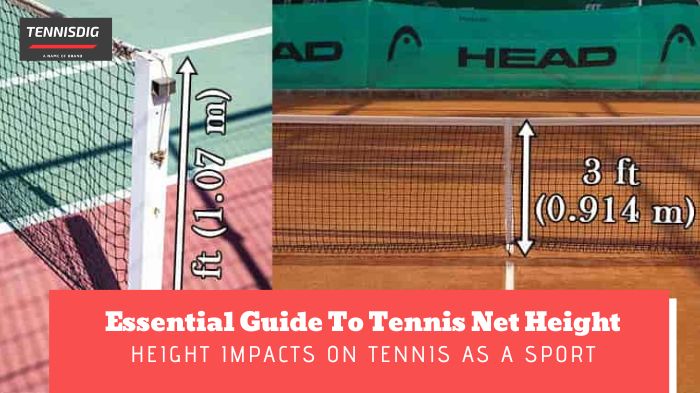As tennis is a game characterized by precision and strategy, its height of net is a central element that shapes its dynamics. A tennis net acts as a symbolic barrier requiring precision from players attempting to outwit opponents; we will explore its precise measurements and regulations while understanding how this height impacts on tennis as a sport, along with any strategic nuances it introduces.
Height of Tennis net
Regulation Standards:
The International Tennis Federation (ITF), as the global governing body for tennis, carefully outlines standards and specifications for a tennis net. ITF regulations call for its height to be 3 feet at its center post; this measurement takes into account ground level to the top of the net; with further extension up to 3 feet and 6 inches (1.07 meters). These gradations adjustments create uniformity across its entirety.
Standardization of play at all levels – from amateur matches on local courts to grand stages tournaments – is vitally important to maintain consistency across the entire spectrum of tennis competition.

Impact on Game Dynamics:
A tennis net’s seemingly modest height plays an essential part in shaping the dynamics of a match. It presents both challenges and opportunities to players, impacting strategies, shot selection, and overall gameplay.
Serve and Volley Tactics:
The height of a tennis net plays a crucial role in serve and volley tactics. A lower net allows servers to focus more closely when trying to clear it with their serves, creating less margin for error for server errors when serving and opening up opportunities for aggressive net approaches for more effective volley play.
Groundstrokes and Net Clearance:
As part of their baseline rallies and groundstroke exchanges, players encountering the net as an ever-present barrier. Due to its height, executing shots accurately requires precise shots aimed at clearing it with their intended trajectory while clearing it without breaking its path through. Achieve an optimal balance between power and accuracy is central to tennis strategy.
Lobbing Techniques:
A tactical response to net challenges is the lob, a shot whereby the ball is launched high above opponents and net. Players employ this tactic in order to successfully navigate height of net, creating opportunities to change rhythm of game play, disrupt opponent positioning and set up potential winning shots.
Net Play and Volleys:
The height of the net is of great significance when engaging in net play or volleys. A lower net requires greater agility and finesse when performing volleys; players must account for its height when maneuvering close to it. Net players often rely on quick reflexes and precise techniques in order to handle shots at the net efficiently.
Strategic Adaptations:
The height of the net adds another factor into the calculation process of altering strategies, prompting real-time decisions on shot selection, court positioning, and game tactics that require real time decision making from both player.
Ensuring Uniformity and Fair Play:
The International Tennis Federation’s (ITF) regulation of net height serves more than just to shape its dynamics; it ensures uniformity and fairness throughout all tennis matches played – be it local club matches, school tournaments or Grand Slam events. No matter where these matches take place – be they at local club courts, school competitions or Grand Slam tournaments – net height remains consistent across courts without encountering variances that compromise its integrity.
Conclusion
Tennis’ intricate dance of serves, volleys and baseline rallies is highlighted by an unsung but crucial player: the height of the net. At three feet at center and three feet 6 inches at posts, this element sets the scene for each match’s strategic battles and requires precision, finesse and strategic acum from players; becoming both an obstacle to overcome as well as an opportunity to demonstrate skill. When viewing matches online or watching them live on TV, fans often overlook how central this unassuming element becomes in creating its narrative and shaping the sport as an engaging pursuit: shaping its legacy forever as dynamic and strategic pursuit!

